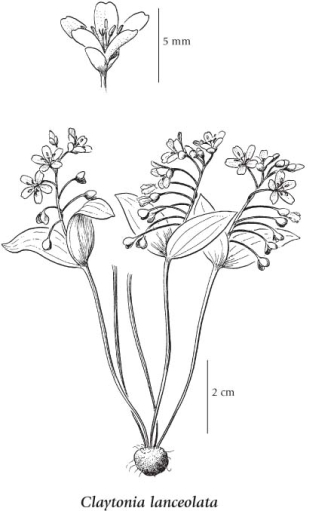Claytonia lanceolata Pall. ex Pursh
western springbeauty (lanceleaf springbeauty)
Montiaceae (Purslane family)
(Previously in Portulacaceae)
Introduction to Vascular Plants
western springbeauty (lanceleaf springbeauty)
Montiaceae (Purslane family)
(Previously in Portulacaceae)
Introduction to Vascular Plants
Species Information
General:
Perennial herb from a spherical underground corm bearing fibrous roots; stems ascending to erect, simple, single to several, 5-25 cm tall.
Leaves:
Basal leaves 1 or 2, elliptic to broadly oblanceolate, the blades 2-15 mm wide, up to 15 cm long including the threadlike underground stalk; stem leaves paired, opposite, free, usually unstalked, narrowly lanceolate to egg-shaped, 1.5-6 cm long, 5-20 mm wide, smooth.
Flowers:
Inflorescence of loose racemes with 3-20 flowers on stalks 1-5 cm long, with one bract subtending the lowest flower; petals 5, white or pinkish or pink-veined, 5-12 mm long, joined at the base for 1-2 mm; sepals 2, 3-7 mm long.
Fruits:
Capsules, egg-shaped, 4 mm long; seeds 3-6, round, black, shiny, 2-2.5 mm long.
Notes:
Plants with stalked stem leaves from Vancouver Island and NW WA have been recognized as var. pacifica. Since plants with stalked stem leaves occur in populations of the species elsewhere in BC and WA this form does not appear significant. The yellow-flowered form (var. chrysantha), found just to the south of the BC border in NW WA was also shown to be synonymous with this species (Douglas and Taylor 1972).
Illustration

If more than one illustration is available for a species (e.g., separate illustrations were provided for two subspecies) then links to the separate images will be provided below. Note that individual subspecies or varietal illustrations are not always available.
Illustration Source: The Illustrated Flora of British Columbia
Ecology
Ecological Framework for Claytonia lanceolata
The table below shows the species-specific information calculated from
original data (BEC database) provided by the BC Ministry of Forests and Range.
(Updated August, 2013)
The table below shows the species-specific information calculated from
original data (BEC database) provided by the BC Ministry of Forests and Range.
(Updated August, 2013)
| Site Information |
Value / Class |
||
|
Avg |
Min |
Max |
|
| Elevation
(metres) |
1945 | 29 | 2500 |
| Slope
Gradient (%) |
26 | 0 | 120 |
|
Aspect (degrees) |
207 | 0 | 360 |
| Soil
Moisture Regime (SMR) [0 - very xeric; 4 - mesic; 8 - hydric] |
3 | 0 | 8 |
| Modal
Nutrient Regime
Class |
C | ||
| #
of field plots species was recorded in: |
357 | ||
| Modal
BEC Zone Class |
ESSF | ||
|
All BEC Zones (# of stations/zone) species was recorded in |
AT(63), BAFA(3), BG(5), CWH(1), ESSF(195), ICH(3), IDF(16), IMA(24), MH(2), MS(3), PP(3) | ||
|
Source:
Klinkenberg 2013
|
|||
Habitat and Range
Moist meadows, shrublands, grasslands and snowbed sites from the steppe to alpine zones; common in S BC (rare on Vancouver Island); E to SK and S to NM and CA.Status Information
Synonyms
Synonyms and Alternate Names:
Claytonia lanceolata var. chrysantha (Greene) C.L. Hitchc.
Claytonia lanceolata var. flava (A. Nelson) C.L. Hitchc.
Claytonia lanceolata var. lanceolata Pall. ex Pursh
Claytonia lanceolata var. pacifica McNeill
Claytonia lanceolata var. rosea (Rydb.) R.J. Davis